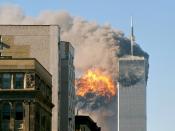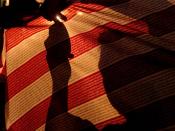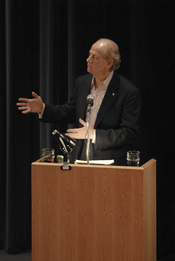Image: Just Another Product on the Market In today's modern society, the use of imagery is becoming more and more relied upon as a primary source of information. For most people, images are often the only form of input they take the time to absorb. Images are preferred because they are fast and require the least amount of time to take in. People are bombarded with images everyday on television, the Internet, and increasingly in the newspapers. Some say that it is the marvel of modern technology, but are they right? People today are quick to accept news images as being true representations of whole stories. They don't stop to take the time to inform themselves with the real facts; they just assume they have been given the icing on the cake. The problem with this type of mentality is that peoples opinions are being influenced and manipulated. Corporations providing news media are nothing more than businesses that are selling a product.
Because of this, people are only subjected to a certain percentage of the world's current events; the ones the corporations think will make the best products to sell.
John Ralston Saul writes in his book, The Doubter's Companion, that he believes images assume three dangerous forms for societies devoted to illusion. He says the first form is "the image that the creator knows to be untrue but expects to convince the public is true."ÃÂ This type of imagery can be considered as being a blatant lie and it can be corrected because it is specific. The second form is "the image that the creator knows to be untrue and does not expect to fool the public; just distract or disorient them."ÃÂ The danger involved in such imagery is that it leads people ignore the true meanings of the subject. The third form can be considered to be the most dangerous of all; it is "the image in which the creator comes to believe."ÃÂ The severity of this type of imagery is that it involves the denial of what's real by the people who have the largest influences on the rest of the populace. John Ralston Saul believes that because images are the simplest way to convince people of untruths, that people are in danger of being controlled without knowing it. He believes the problem is even more serious in this day of age because it has become surprisingly simple to electronically manipulate images.
Saul's analysis of image can be applied to the situation that the public has been living in since the terrorist attacks on Sept. 11, 2001. Since the day of the attacks, the public has been subjected to numerous images on the news. Literally every news station had stopped its regularly scheduled programs, and was broadcasting coverage of the attacks day and night for a whole week. The average person must have seen the image of the planes flying into the twin towers an overabundance of times. Should this amount of coverage been given to a single event? Through the medias barrage of imagery, all of North America and other parts of the world were led to believe that it was the most important event that has ever happened. Granted, this was a terrible tragedy and thousands of people died, but the number of deaths that occurred in New York is just a fraction of the number of deaths that occur everyday in other countries as a result of militaristic chaos. Are the Americans more important than the rest of the world? The news images that the public has been subjected to lately could be categorized under the second form of imagery that Mr. Saul talked about. These images cover only half of the whole story of the conflict between the United States and Afganastan. These images were not designed to fool anyone, but they sure distracted and disoriented many. Very little, if any at all, news coverage showed the bombing sites after the U.S. missile attacks in Afganastan the first time they tried to kill Osama Bin Ladin. Pictures like that were only seen on the Afganastan news. The news coverage in the U.S., only two hours after the attacks, had begun putting the blame on the Arabs. They could not have possibly had any concrete evidence at that time; they just tried to sell the story they thought the American public would like to buy. In the United States, the news broadcasters were careful only to cover the stories they deemed "pro-American."ÃÂ In other countries that were more neutral in these events, more coverage was available that showed images of both sides.
The danger in these images may be difficult to see, but they have affected many. Several companies, such as Air Canada, used these images as scapegoats for problems that already existed. This airline company was already facing financial problems and was going to have to lay off many of its workers. With the use of the images of the attacks, Air Canada had something to blame for its financial problems. As a result, thousand of Air Canada employees lost their jobs. To make it worse, these former employees can't complain because Air Canada has a good excuse.
Even though images can pose as dangers to our societies, they are becoming increasingly the way of the future. It's a difficult problem to fix because there is no one person or company at fault; everybody is guilty at one point or another. How can this problem be fixed if nobody really cares?





